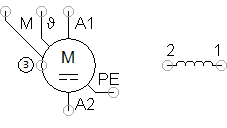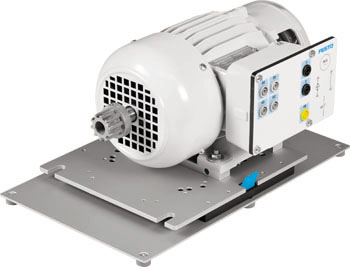DC separately excited motor


The separately excited DC motor is a machine for converting electrical energy into mechanical energy (rotary motion). Its armature and excitation windings are supplied with power from different voltage sources.
Terminals A1-A2 are used to connect the armature winding and terminals 1-2 are used to connect the excitation winding. Terminal 3 is a rotary terminal mechanism. A motor test bench or a further motor can be connected here, for example. (The direction of rotation is usually reversed via the connection. This can be selected with the connecting cable.) The other electrical terminals are used for connection to the electrical section of the motor test bench.
Armature and excitation winding connections can be selected in the motor’s parameters under Characteristic data. The selection of these connections influences automatic calculation of winding resistances. The desired performance values are only attained if the motor is externally wired as specified in the parameters.
Idling speed of the motor can be indicated as a ratio to nominal rotary speed with the parameter Idle revolution : Rated speed. The absolute value of idling speed is determined by multiplying nominal speed by the specified ratio (e.g. nominal rotary speed 2000 rpm * 1.1 = idling speed 2200 rpm).
Adjustable parameters
| Designation | Range | Default value |
|---|---|---|
| Characteristic data | Shunt-wound machine, Series-wound machine | Shunt-wound machine |
| Power | 0.001 ... 1000 kW | 0.3 |
| Revolution | 1 ... 30000 1/min | 2000 |
| Designation | Range | Default value |
|---|---|---|
| Voltage | 1 ... 10000 V | 220 |
| Current | 0.1 ... 100 A | 1.8 |
| Inductance | 1e-6 ... 10 H | 0.01 |
| Designation | Range | Default value |
|---|---|---|
| Voltage | 1 ... 10000 V | 220 |
| Current | 0.01 ... 100 A | 0.3 |
| Inductance | 1e-6 ... 10 H | 0.01 |
| Designation | Range | Default value |
|---|---|---|
| n_0 : n_N | 1.001 ... 100 | 1.1 |
| Designation | Range | Default value |
|---|---|---|
| External torque | 0 ... 100 N.m | 0 |